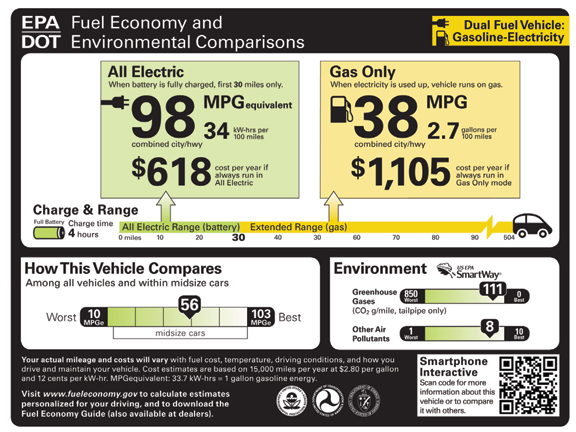The EPA labels that report fuel efficiency on new cars are being redesigned. The press recently reported that many people found the new labels confusing. I didn’t look into the details–that many people find just about any label confusing isn’t much of a shock to me.
If I had taken a closer look, I would have noticed that the new labels will do something I proposed here some time ago, but expected would not be done in the interest of simplicity: posting separate numbers for each fuel type. GM angled for a 230 MPG rating for the new Chevrolet Volt based on the old, single number system. The Volt could get such a number because it runs the first 40 or so miles on electricity alone. So, aside from simplicity, the industry had an interest in maintaining the old system.
 Instead, it looks like the EPA will post two numbers for vehicles like the Volt: one in energy equivalent for the first 30 miles run on electricity, and a second for MPG on gas once the battery has been depleted. Car & Driver posted the potential new sticker you see here in its new review of the Volt. This is the right thing to do. Any single number would assume an arbitrary split between electric-only and gasoline-assisted driving. Play the split right, and suddenly you’re getting 200+ MPG. But not really.
Instead, it looks like the EPA will post two numbers for vehicles like the Volt: one in energy equivalent for the first 30 miles run on electricity, and a second for MPG on gas once the battery has been depleted. Car & Driver posted the potential new sticker you see here in its new review of the Volt. This is the right thing to do. Any single number would assume an arbitrary split between electric-only and gasoline-assisted driving. Play the split right, and suddenly you’re getting 200+ MPG. But not really.
One step back: no separate numbers for city and highway, probably because including four numbers was judged to be overwhelming. Personally, I hope that separate city/highway numbers are at least available, if not on the sticker.
The only other thing I asked for, but that does not appear to be happening: an EPA rating for electric-only range. How far can you drive before going from the first number to the second?